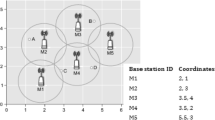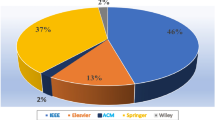Abstract
Provisioning buffer management mechanism is especially crucial in resource-constrained delay tolerant networks (DTNs) as maximum data delivery ratio with minimum overhead is expected in highly congested environments. However, most DTN protocols do not consider resource limitations (e.g., buffer, bandwidth) and hence, results in performance degradation. To strangle and mitigate the impact of frequent buffer overflows, this paper presents an adaptive and efficient buffer management scheme called size-aware drop (SAD) that strives to improve buffer utilization and avoid unnecessary message drops. To improve data delivery ratio, SAD exactly determines the requirement based on differential of newly arrived message(s) and available space. To vacate inevitable space from a congested buffer, SAD strives to avoid redundant message drops and deliberate to pick and discard most appropriate message(s) to minimize overhead. The performance of SAD is validated through extensive simulations in realistic environments (i.e., resource-constrained and congested) with different mobility models (i.e., Random Waypoint and disaster). Simulation results demonstrate the performance supremacy of SAD in terms of delivery probability and overhead ratio besides other metrics when compared to contemporary schemes based on Epidemic (DOA and DLA) and PRoPHET (SHLI and MOFO).











Similar content being viewed by others
References
Vasilakos, A. V., Zhang, Y., & Spyropoulos, T. (2012). Delay tolerant networks: Protocols and applications. Boca Raton: CRC Press.
Spyropoulos, T., et al. (2010). Routing for disruption tolerant networks: Taxonomy and design. Wireless Networks, 16(8), 2349–2370.
Jones, E. P., Li, L., Schmidtke, J. K., & Ward, P. A. (2007). Practical routing in delay-tolerant networks. IEEE Transactions on Mobile Computing, 6(8), 943–959.
Spyropoulos, T., Psounis, K., & Raghavendra, C. S. (2004). Single-copy routing in intermittently connected mobile networks. In First annual IEEE communications society conference on sensor and ad hoc communications and networks (IEEE SECON 2004) (pp. 235–244).
Vahdat, A., & Becker, D. (2000). Epidemic routing for partially connected ad hoc networks (p. 18). Technical report CS-200006, Duke University.
Lindgren, A., Doria, A., & Schelén, O. (2003). Probabilistic routing in intermittently connected networks. ACM SIGMOBILE Mobile Computing and Communications Review, 7(3), 19–20.
Spyropoulos, T., Psounis, K., & Raghavendra, C. S. (2005). Spray and wait: An efficient routing scheme for intermittently connected mobile networks. In Proceedings of the 2005 ACM SIGCOMM workshop on Delay-tolerant networking (pp. 252–259).
Zhang, X., Neglia, G., Kurose, J., & Towsley, D. (2007). Performance modeling of epidemic routing. Computer Networks, 51(10), 2867–2891.
Balasubramanian, A., Levine, B. N., & Venkataramani, A. (2010). Replication routing in DTNs: a resource allocation approach. IEEE/ACM Transactions on Networking, 18(2), 596–609.
Sandulescu, G., & Nadjm Tehrani, S. (2010). Adding redundancy to replication in window-aware delay-tolerant routing. Journal of Communication, 5(2), 117–129.
Shin, K., & Kim, S. (2011). Enhanced buffer management policy that utilises message properties for delay-tolerant networks. IET Communications, 5(6), 753–759.
Elwhishi, A., Ho, P. H., & Shihada, B. (2012). Message scheduling and forwarding in congested DTNs. In Proceedings of the fourth international conference on advances in future Internet, AFIN 2012 (pp. 26–31).
Krifa, A., Barakat, C., & Spyropoulos, T. (2012). Message drop and scheduling in DTNs: Theory and practice. IEEE Transactions on Mobile Computing, 11(9), 1470–1483.
Rashid, S., Ayub, Q., Zahid, M. S. M., & Abdullah, A. H. (2013). Message drop control buffer management policy for DTN routing protocols. Wireless Personal Communications, 72(1), 653–669.
Bitorika, A., Robin, M., Huggard, M., & Mc Goldrick, C. (2004). A comparative study of active queue management schemes. In Proceedings of the ICC.
Barakat, C., Spyropoulos, T., & Krifa, A. (2008). Optimal buffer management policies for delay tolerant networks. In Proceedings of the IEEE conference on sensor, mesh and ad hoc communications and networks (SECON’08).
Krifa, A., Barakat, C., & Spyropoulos, T. (2008). An optimal joint scheduling and drop policy for delay tolerant networks. In IEEE International Symposium on a world of wireless, mobile and multimedia networks (WoWMoM 2008) (pp. 1–6).
Scott, K., & Burleigh, S. (2006). Bundle protocol specification (Internet draft), IRTF.
Whitbeck, J., Conan, V., & Amorim, M. (2009). Tuning message size in opportunistic mobile networks. In Proceedings of the 1st ACM workshop on networking, systems, and applications for mobile handhelds (MobiHeld ‘09) (pp. 75–76).
Qiu, L., Li, Y., Hui, P., Jin, D., Su, L., & Zeng, L. (2012). Edge-markovian dynamic graph based performance evaluation for delay tolerant networks. In Proceedings of IEEE conference on wireless communications and networking (WCNC) (pp. 2129–2133).
Ayub, Q., & Rashid, S. (2010). Effective buffer management policy DLA for DTN routing protocols under congestion. International Journal of Computer and Network Security, 2(9), 118–121.
Rashid, S., Ayub, Q., Zahid, M. S. M., & Abdullah, A. H. (2011). E-drop: An effective drop buffer management policy for DTN routing protocols. International Journal of Computer Applications, 13(7), 8–13.
Rashid, S., Abdullah, A. H., Zahid, M. S. M., & Ayub, Q. (2012). Mean drop an effectual buffer management policy for delay tolerant network. European Journal of Scientific Research, 70(3), 396–407.
Jain, S., & Chawla, M. (2014). Survey of buffer management policies for delay tolerant networks. The Journal of Engineering, 1(1), 1–7. doi:10.1049/joe.2014.0067.
Ott, A. J., & Krkkìnen Kernen, T. (2009). The ONE simulator for DTN protocol evaluation. In Proceedings of the 2nd international conference on simulation tools and techniques (Simutools’09).
Boleng, J., Davies, V., & Camp, T. (2002). A survey of mobility models for ad hoc network research. Wireless Communications and Mobile Computing (WCMC): Special issue on Mobile Ad Hoc Networking: Research Trends and Applications, 2(5), 483–502.
Harris, A. F., Kravets, R., & Nelson, S. C. (2007). Event-driven, role-based mobility in disaster recovery networks (CHANTS’07).
Liu, J., et al. (2013). Towards key issues of disaster aid based on wireless body area networks. KSII Transactions on Internet and Information Systems, 7(5), 1014–1035.
Chen, M., et al. (2014). A survey of recent developments in home M2M networks. IEEE Communications Surveys and Tutorials, 16(1), 98–114.
Imran, M., Alnuem, M. A., Fayed, M. S., & Alamri, A. (2013). Localized algorithm for segregation of critical/non-critical nodes in mobile ad hoc and sensor networks. Procedia Computer Science, 19, 1167–1172.
Acknowledgments
Imran would like to extend his sincere appreciation to the Deanship of Scientific Research at King Saud University for funding his research through Research Group Project (RG No. 1435-051).
Author information
Authors and Affiliations
Corresponding author
Rights and permissions
About this article
Cite this article
Moetesum, M., Hadi, F., Imran, M. et al. An adaptive and efficient buffer management scheme for resource-constrained delay tolerant networks. Wireless Netw 22, 2189–2201 (2016). https://doi.org/10.1007/s11276-015-1085-y
Published:
Issue Date:
DOI: https://doi.org/10.1007/s11276-015-1085-y




